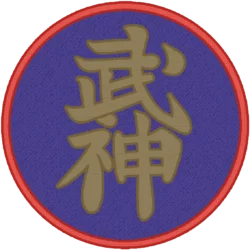
Bujinkan Dojo the 9 schools. The schools are hundreds of years old, but the Bujinkan is new. Bujinkan Dojo was founded by 初見良昭 Masaaki Hatsumi Sōke after his teacher passed away in 1972.
Upon encountering his teacher, Hatsumi sōke experienced fear for the very first time in his existence. Despite being around 27 years old and having encountered numerous martial arts masters and street thugs, he had never been intimidated by anyone until then.
Takamatsu sensei was a 70 year old martial arts master with 20 years of actual combat experience in China during the early 1900’s. Hatsumi Sōke felt that he was as powerful as a warrior god. Takamatsu sensei passed away in April 1972. Later on Hatsumi Sōke named the organisation to 武神館道場 Bujinkan Dojo in honour of his teacher. More about Takamatsu here if there is interest.
武道体術 Budō-taijutsu
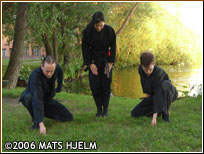
The art that we in Bujinkan Dōjō practice is generally called Budō-taijutsu. But there is many different arts in the Bujinkan system. For example, Jūjutsu, Jūtaijutsu, Dakentaijutsu, Koppōjutsu, Kosshijutsu, Ninpō-taijutsu, Yoroi-kumiuchi.
These are all unarmed combat systems both with and against yoroi (armor) and of course also without armor. All the styles are slightly different from each other with different focus on how to handle combat situations.
Then there is also many, many weapons taught in the curricullum. Weapons such as knife and swords of various lengths. Sticks and staffs of various lengths. Pole arms and spears. Big heavy battle weapons. Flexible weapons such as ropes and chains. Projectile weapons such as throwing spikes and stars.
In the traditions there is also knowledge how to use explosives. Guns, cannons etc but this is not really practiced anymore.
初見良昭 Hatsumi Masaaki
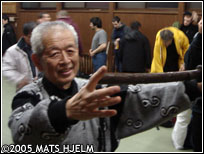
Hatsumi Sōke was born December 2’nd 1931. He retired from actively teaching in 2020. The 武神殿 Bujinden (the Bujinkan honbu dōjō in Noda-shi, Chiba-ken, Japan) is still open for training. Hatsumi Sōke started training martial arts when he was seven years old. He studied most of the modern Japanese martial arts such as Kendo, Judo, Karate, but also western boxing.
Sōke also played soccer and social dancing. He graduated from Meiji University with a major in theatre production. He also studied medicine and opened his chiropractic clinic in Noda city.
In addition to his martial arts background he is a highly respected writer, and artist. Hatsumi Sōke have produced many books videos about Japanese Budō and culture. He played guitar in a hawaiian music band in his teens. And he was also an advisor or director for many films and TV series during the 60’s and 70’s. Most famous here in the west is probably the Shinobi no mono movies starring Ichikawa Raizo. But also Chokugeki Jigokuden and Kage no gundan both starring Sony Chiba.
He also acted as Yamaji Tetsuzan in the Asahi TV series in the late 80’s. He is an accomplished Nihonga style artist of brush and ink. His art work have been exhibited in various galleries around the world. He is also a collector of antiquities, and dreams of opening a Budō museum for people interested in martial arts (donations is welcome) in the future.
Hatsumi sōke have received numerous prices and awards from high positioned leaders from all around the world for his work. I did list most of these awards on my previous website (here is one copy), I plan to put it here again and update it if there is interest.
九伝 History
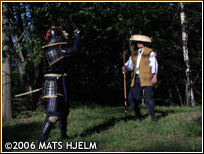
The origin of our budō comes from “China and the lands beyond” more than 2500 years ago, some records go as far back as to 4300 years ago. Fighting methods with sticks and stones have probably been around since the homo sapiens first appeared.
The legends say that 忍の者 Shinobi no mono (poularly called ninja) was involved “behind the scenes” in ōkume no Mikoto’s nation-bulding operations and Emperor Jimmu’s subjugation of Yamato around 600 BC. Some old dokuments also say that Prince Shotoku (574-622 BC) used Shinobi. During the T’ang dynasty (618-907 AD) two persons from China named Yao Yu Hu and Zhang Wu Sheng brought their martial arts to the mountain regions of Iga (today Shiga prefecture) where they taught the locals Hichō-jutsu and Senban-nage among other arts.
Another legend tell us the story about General Yi Gou who fled from military defeat in China and landed at Ise where he hid in the Sada caves close to Iga and practized Zen meditation. Yi Gou was a master of Hichō-ongyō-jutsu. After some generations these teachings formulated into different ryū-ha (schools) of martial arts.
In the early 1900’s 高松寿嗣 Takamatsu Toshitsugu learned all nine schools (and more) from three masters. He had many students but at the end of his life he had only one true student left, and that was Hatsumi Yoshiaki who changed his sir name to Masaaki (same kanji but different pronunciation).
Hatsumi sōke trained with Takamatsu sensei for 15 years and learned everything, in 1968 he was appointed to be the next grandmaster for all nine schools by Takamatsu sensei.
The following poem was written by Takamatsu sensei to Hatsumi sōke.
Long ago I was an accomplished warrior of the Koppōjutsu tradition.
I was courageous, and as intense as a flame, Even in battle against dangerous animals.
I have a heart that is like the wild flowers of the meadow,
And yet as straight and true as the bamboo.
Not even ten thousand enemies can cause me fear.
Who is there in the world who can keep alive this will of the warrior’s heart?
There you are.
This one sent to me by the Warrior Gods (武神 = Bujin).
I have been here waiting for you through the ages.
Takamatsu sensei died on April 2, 1972 at the age of 85 and Masaaki Hatsumi became the head master of the nine ryū-ha we have in the Bujinkan Dōjō.
手解き Introduction of Bujinkan to the west
It was after the first book in English about Ninjutsu (Ninja, the invisible assassins by Andrew Adams) in 1970 when the first westerners started to get in contact with Hatsumi sōke. Doron Navon from Israel had already found Hatsumi sōke in 1969, he went home after five years training with Hatsumi sōke in 1974 and opened the first dōjō outside Japan in Tel Aviv, Israel.
Around the same time Stephen Hayes from USA moved to Japan for training, he moved back home to USA and introduced Bujinkan in 1980 to the americans. Ishizuka sensei, one of the Japanese Shihan was invited by Bo Munthe to Sweden on his honeymoon in 1974 for a short visit, Bo Munthe visited Japan the following year for two weeks and met and trained with Hatsumi sōke for the first time. He then went back home with 1’st Dan and was allowed to open a dojo in Stockholm under supervision of Ischizuka sensei.
In the early 80’s the big “ninja-boom” came in the west and everyone wanted to be a ninja. The word “Ninja” and “Ninjutsu” was widely used effectively because it was what many people wanted and it was easy to get many, many students. But there was really not much Ninjutsu taught. Hatsumi sōke was teaching from all schools under the name Togakure-ryu Ninjutsu because the people wanted to learn Ninjutsu. Later on it was called Bujinkan dōjō Ninpō-taijutsu until 1995 when sōke deiced to change it to Bujinkan dōjō Budō-taijutsu.
The training in Japan had been very tough in the 70’s as sōke was struggling hard to feel worthy for the legacy of Takamatsu sensei, he said that it took him 30 years of hard training to feel worthy (15 years of training with Takamatsu sensei, and another 15 years of hard training and testing the effectiveness of the style).
He trained so hard that he got sick. The training in the west was also hard and tough in the 80’s but for another reason, the art was still young and everyone teaching and writing books only had a few years of experience in the art. Often the lack of technique made the trainings dangerous and violent wich resulted in many unnessesary accidents.
Today the art here in the west is more mature and the level is much higher. But there is still a lot more to learn from Hatsumi sōke and the shihan. If you choose a random date anytime of the year there is around 50-100 foreigners training with Hatsumi sōke in Japan. This does not mean that the training is bad outside Japan, on the contrary it is really good. There is many good instructors everywhere, but if you want to train with the best you still have to go to Japan.
現代武道 Modern day use and practice
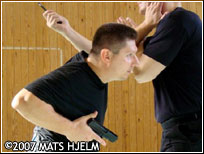
The techniques, principles and feelings from the old is still valid today! The Bujinkan system is taught to suit our modern day society for self defence for civilians, but also for special forces, police etc.
Hatsumi Sōke have taught people from police, special forces and agencies all around the world who can testify that what he teach is still very practical and useful even today.
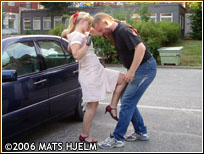
One very important thing that makes Bujinkan unique is that you don’t need to learn each and every weapon there is as a separate art. The Bujinkan system teach us how to use whatever object we have in our hands effectively.
It doesn’t look spectacular. It doesn’t look beautiful.
And if the technique is good you can’t even see what happened. Many times the one who received the technique don’t know what happened. Maybe even the one who did the technique don’t know or can explain it. This is the feeling of a Bujinkan technique, something that is very difficult to explain.
有ると思ったら無い;無いと思ったら有る。
(aru to omottara nai – nai to omottara aru)
This is one of Hatsumi Sōke favourite poems and it means something like; If you think it is there, it is not; if you think it is not there, it is. This might be very difficult to grasp, but consider if you think you understand you probably don’t.
Hatsumi Sōke have said many times that the invisible training starts after the 5’th Dan test. So even if you have seen videos on Youtube and think it looks like bullshit, please visit one of the many Shihan in Bujinkan and taste our art. Use your gut feeling, don’t judge us by bad examples on Youtube, don’t judge us because you don’t understand, or get the full feeling. Many things you need to feel to understand.
Hatsumi Soke retires and 8 new Soke
Hatsumi Soke retired from teaching (officially) from January 2020 being 90 years old right before the virus shut down the whole world. Around the same time he announced 8 new Soke for all the 9 Ryu-ha.
- Tsutsui Takumi 35’th Sōke of Togakure-ryū
- Ishizuka Tetsuji 29’th Sōke of Gyokkō-ryū
- Iwata Yoshio 29’th Sōke of Kukishin-ryū
- Nagato Toshirō 27’th Sōke of Shindenfudō-ryū
- Kan Jun’ichi 22’nd Sōke of Gyokushin-ryū
- Noguchi Yukio 19’th Sōke of Kotō-ryū
- Sakasai Norio 18’th Sōke of Takagiyōshin-ryū
- Sakasai Norio 16’th Sōke of Gikan-ryū
- Furuta Kōji 16’th Sōke of Kumogakure-ryū
Study Bujinkan in Japan
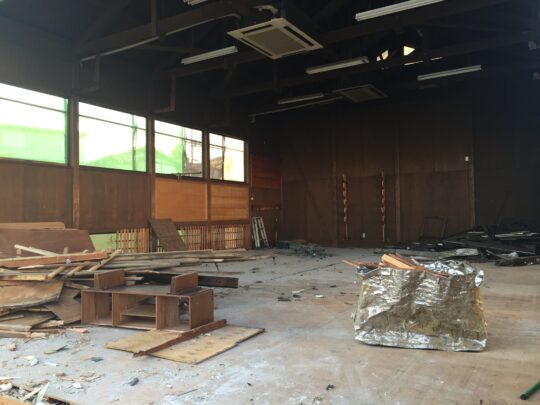
If you are a beginner I recommend you to start training in a local Dōjō under a qualified Shidōshi or Shihan until you have reached at least 1’st Dan (about 2-3 years hard training). There is no need to go prior to this.
The new Honbu Dojo was opened in February 2015 about 100 meters up the rail road tracks.
The Honbu Dojo opened up again after the “virus years” in January 2023. Many of the new Soke and Dai Shihan is teaching in Honbu Dojo weekly.
The trainings in Japan is on a high level which requires that you know the basics well. In fact you don’t need to go to Japan until you are a 4’th Dan (at least 8 years hard training). there is many Dai Shihan around the world that have trained for a very long time.
If you go on the other hand, there is many things you should know that is not written down anywhere. Japan is a very different country than the western countries, it is very easy to make mistakes so be careful!